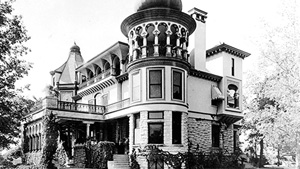A pioneer Grigsby family figures into the early days of Dallas County, though none appear to have ever resided in the county. The patriarch of that family was John Grigsby (1787 – 1841). John Grigsby was believed to have been born in Virginia. He married Hester Sharp (1799 – 1831) in 1817 while living in Indiana. There Hester and John had all of their eight children. Hester died in 1831 and two years later John married Eliza Louisa Thompson (1815 – 1843). The following year, 1834, Louisa and John moved to Texas, first settling in the Teneha area.
Some time later, the John Grigsby family moved a bit further west to Nacogdoches/Houston County on San Pedro Creek. They settled across the creek from the Edens family some of whom along with women and children of other families were victims of an 1838 raid presumed to have been carried out by a group of Kickapoo warriors. The raid came to be called the Edens-Madden Massacre and occurred in October of 1838. The men were apparently away. A number of women and children from several families had gathered together in a dog trot style log house and many were killed. There were at least two survivors including an injured woman, Lavinia Langford Edens, the wife of John Edens and a four year old boy, Balis Erls Madden. The families had some common first names, but it is unknown if the Edens and Maddens were directly related. Though the Grigsbys lived across the creek, close enough to hear the attack, no members of the Grigsby family were among the victims. Fearing for their own lives, they had disappeared into the foliage around their home and were not attacked.
John Grigsby drowned in 1841 when he went overboard on the Trinity River as he was attempting to take a load of cotton downriver to sell at Galveston. The following year his widow Eliza Louisa Grigsby married Balis Edens in Houston County. Balis Edens (1802 – 1873) was an older son of the Edens family who had lost two children in the Edens-Madden attack in 1838. Balis would have been in his 30s at the time and does not appear to have been living with the rest of the family when the event occurred. Bolis and Louisa had twin daughters, one of whom survived, before Louisa died in 1843. In the meantime, John had been granted a league and a labor of land in what became Dallas County, more specifically including what would eventually become part of downtown Dallas.
While they were living, John and Louisa had apparently sold about one-third of their 4,605 acres. Neither John nor Louisa left a will, so the inheritance of the remainder was in disarray. After Louisa’s death in 1843, Balis Edens had married Ruth Ann Grigsby, a daughter of John and Hester Grigsby and technically a step daughter of his late wife Louisa. The heirs by the time of Lousia’s death would have included the surviving children of John and Hester, possible children or grandchildren of John and Louisa and the surviving child of Louisa and Balis.
The litigation over the Grigsby inheritance was lengthy but was eventually settled and individual parcels of the property were conveyed to other owners. The boundaries of the original league and labor granted to John Grigsby has been described as a rectangle extending between Turtle Creek south to Grand Avenue and from Lamar Street to Henderson Avenue.” (A. C. Greene, Dallas Morning News, September 1, 1991.) To the southeast, it was bordered by the similarly sized Thomas Lagow parcel. John Neeley Bryan’s property appears to have been at the southern tip of the Grigsby land. Today the former Grigsby League would include most of downtown Dallas, in addition to what is called Uptown, Oak Lawn, Deep Ellum. It would extend to the pre-levee banks of the Trinity, and appears to also extend to at least some of Fair Park. The boundaries include a number of cemeteries including Pioneer, Greenwood, Freedmans, Temple Emanu-El and possibly others.
The burial places of John Grigsby and Eliza Louisa Grigsby Edens are currently unknown. Balis Edens, Ruth Ann Grigsby Edens (1826 – 1884) and many of their family are buried in the Balis Edens Cemetery in Grapeland, Houston County, Texas.
By Mike Magers


